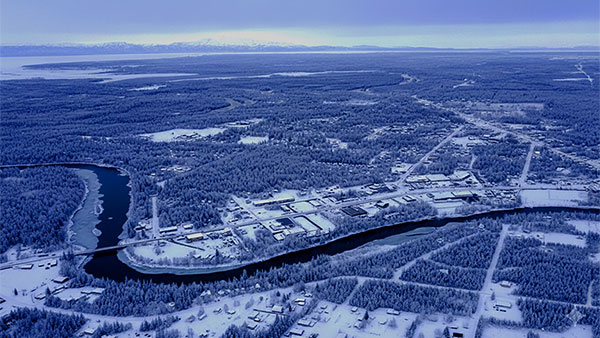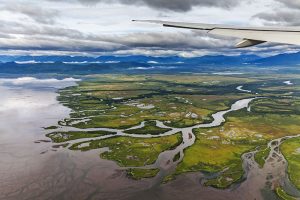Alaska’s relationship with snow isn’t just about winter sports or scenic postcards. When temperatures rise and snowpack begins its inevitable melt, the Last Frontier faces one of its most consistent (and costly) natural hazards. For residents across the state, spring doesn’t just mean longer days and budding wildlife. Snowmelt also means flood season in Alaska.
Flooding is a common natural disaster in the United States. In fact, the National Weather Service (NWS) states that around 75% of all Presidential disaster declarations are associated with flooding. The agency further notes that the most common cause for this is rain and/or snowmelt. Flooding due to snowmelt typically affects the country’s northern states and mountainous areas.
In Alaska, snowmelt is among the most frequent flood types, according to the state’s Department of Natural Resources, and it affects communities like those in the Kenai Peninsula. Snowmelt flooding is an annual threat in the state, which means that for Alaskan communities, it’s less a question of “if” and more about “how severe.”
However, snowmelt flooding in Alaska operates differently than the dramatic river flooding most people imagine. Here’s how it works.
The Science Behind Alaska’s Snowmelt Flooding
Snow is the result of high temperatures freezing water vapor in the air, which then falls to the ground as ice crystals. In areas like Alaska or on top of mountains, this layer of snow does not melt for months and becomes the first of multiple layers of snow from different snowfall to form a snowpack, where each new layer of snow compacts or compresses the layer/s underneath it.
The snowpack will only start to melt when temperatures reach above-freezing figures, such as in spring. Then, the snowpack will start to melt, and the water from this melting snowpack is the snowmelt.
Because of this, snowmelt is an important water source for streams and reservoirs. For instance, California relies on snowmelt for one-third of the water supply used in its cities and farms. And, as much as 75% of some western states’ water supplies come from snowmelt, according to the U.S. Geological Survey.
“The amount of water released by snowmelt varies, depending on the density of the snow,” the National Geographic explains. “Wet, heavy snow can release about 3.8 centimeters (1.5 inches) of water per 30 centimeters (12 inches) of snow. Lighter, drier snow might contain just 2.5 centimeters (1.0 inch) of water per 30 centimeters (12 inches) of snow.”
In Alaska, however, snowmelt is more than just a supply of water. It also determines the viability of the Last Frontier’s hydropower and the reliability of transportation to its remote regions. Snowmelt also affects salmon streams, which are hunted for subsistence, commerce, and sport.
How Snowmelt Flooding Works in Alaska
A big chunk of Alaska’s land (83%) is classified as interior boreal forest and arctic tundra snow climates, so it’s not surprising to know that the state accumulates an impressive amount of snowpack throughout its extended winter season.
When spring temperatures rise (and let’s be honest, “spring” in Alaska can stretch well into May), this frozen water begins converting to liquid runoff. This melting of snowpack accumulated during the winter typically runs off into nearby creeks, streams, rivers, lakes, and reservoirs, which causes them to rise rapidly and overflow their banks. This type of flood is known as snowmelt flooding.
The NWS explains: “Once it begins to melt and does reach the soil, water from snowmelt behaves much as it would if it had come from rain instead of snow by either infiltrating into the soil, running off, or both. Flooding can occur when there is more water than the soil can absorb or can be contained in storage capacities in the soil, rivers, lakes and reservoirs.”
One thing to note is that snowmelt is most often a relatively slow phenomenon, comparable to light or moderate rainfall. However, several factors and conditions can further increase or exacerbate the severity of meltwater floods in the state, including the following:
- High soil moisture conditions prior to snowmelt,
- Rainfall during the late fall,
- Ground frost or frozen soil, especially deep, hard ground frost,
- Deep or heavy snow cover,
- Widespread snow cover,
- Rain falling while snow is still on the ground,
- Unusually warm periods with high dew point temperatures, and
- Nighttime temperatures that remain above freezing.
When Snowmelt Flooding Strikes: Preparing for the Inevitable
Snowmelt flooding in Alaska isn’t just possible; it’s inevitable. The state’s climate, geography, and seasonal patterns create conditions that generate flooding annually in various locations. In other words, spring melt is Alaska’s most predictable natural hazard.
Because of this, you should treat spring flooding as an annual planning requirement, rather than an emergency. This will help you minimize risks, protect yourself and your loved ones, and have a much more effective recovery.
Here are some of the proactive measures you can take to prepare ahead of time:
- Review and familiarize yourself with your community’s Small Community Emergency Response Plan, if it has one.
- One month before an expected spring break up, start making or reviewing your plans, inventory your at-risk belongings, and ensure you have emergency kits and gear readily on hand.
- Two weeks before an expected spring break up, start stocking up on food, water, medications, and other personal emergency items and essential supplies.
- When a flood warning has been issued, it’s time to move your at-risk belongings and items, such as canned and dry goods and potable water, to a higher level to prevent damage. And, if you haven’t already, this is also the time to familiarize yourself with your community’s emergency plan.
- When an evacuation has been issued, follow the instructions from authorities and keep updated of the situation through the various resources available to you, such as your local radio stations or online official channels.
Remember that snowmelt is a gradual process, and it may occur during relatively mild weather. So, residents, businesses, and communities should maintain flood preparedness as an ongoing responsibility rather than a seasonal concern because in Alaska, next spring’s snowmelt season is always just around the corner.


